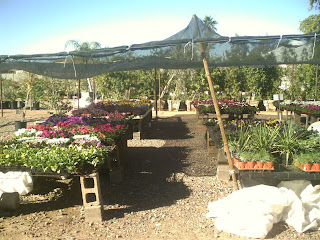 |
| South Mountain Flower Growers 2010 (Photo by Edell Stinnett) |
 |
| South Mountain Flower Growers, 2010 (Photo by Edell Stinnett) |
The agricultural possibilities of land at the basin of Phoenix’s South Mountain had eluded white farmers, whose attempts for various crops in the seemingly barren soil had failed miserably. The desert basin silt was intemperate to attempts for today’s generic crops of alfalfa, cotton, and citrus, due to a lack of adequate water. In 1913, the completion of the Highland and Western Canals provided the South Mountain area with water supplied from the Salt River, and agricultural development in Phoenix flourished as did canaigre (tannin producer for tanning) and the cattle and ostrich industries.
In 1928, Japanese immigrant, Kajiuro Kishiyama began to farm vegetables, canaigre roots and sugar beets, on land he leased in Phoenix. Though the recent passage of the 1921 Arizona Alien Land Law prohibited Japanese Americans and Japanese immigrants, or “Orientals,” from owning land in Phoenix, Mr. Kishiyama had been successful growing flowers before he and his family was relocated to one of two internment camps during World War II. In 1931 a second family, the Nakagawas, and the Kishiyamas both returned to the Phoenix South Mountain area to pursue their previous successes with flowers and future agricultural successes with lettuce and other vegetables. Some contribute agricultural knowledge and skill for the canal irrigation systems of Asia for the Japanese immigrants’ agricultural accomplishments for produce like lettuce for success where white farmer had failed. This and other racial animosities toward the Japanese as “forever foreign,” contributed to an inhospitable environment in Phoenix for Japanese people.
The events of World War II during which Japanese Americans in Arizona and elsewhere on the West coast were interred temporarily as possible enemies of the nation, found that when released, many Japanese American families discovered their personal possessions and properties had been appropriated and redistributed, by law, to white American citizens. The repeal of the Arizona Alien Land Law in 1936, allowed Mr. Kishiyama, Mr. Nakagawa, to purchase land they had previously been denied title to, and by 1946 Japanese American families in Phoenix had created a successful local and commercial nationwide floral enterprise. Eventually, numerous Japanese family farms enjoined the Kishiyama and Nakagawa family farms, forming what was once known as the two lane “Baseline Corridor,” (1) where fresh flowers purchases from local patrons and merchants daily, blossomed into a cultural and ecological niche for Japanese Americans in Phoenix. (2) Today Baseline Road is a six lane tree-lined main thoroughfare of South Phoenix, adorned with a flowering median and residential condominiums, apartments, and small commercial business on one side and across the street are vacant spaces, gated communities, and the Phoenix Baseline Flower Growers flower shop, still dwarfed by the proximity of South Mountain and parallel the Western Canal.
- Edell Stinnett, Carshenia Butler, and Debra Groves
References
1. ProQuest. Copyright 2005 - Arizona Republic - All Rights Reserved. Angela Cara Pancrazio. Arizona Republic. Phoenix, Ariz.: Jan 27, 2005. pg. B.2
2. City of Phoenix Asian American Historic Property Survey. Murray, V. & Solliday, S. Arizona Historical Research.
No comments:
Post a Comment